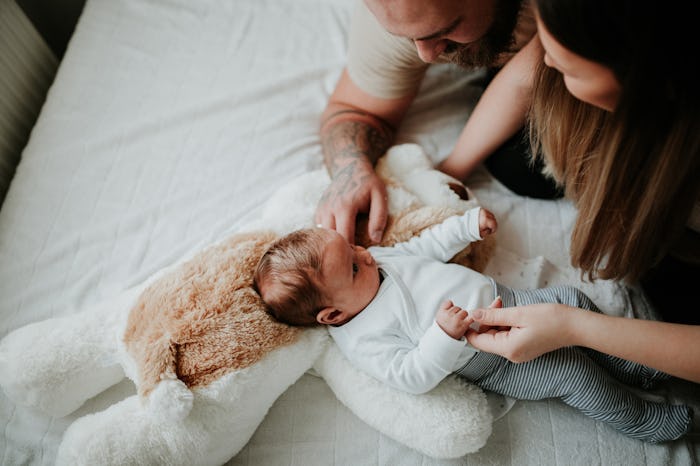Parenting

Don't Panic: Here's Why Your Baby's Hair Is Sporting Some Little Bald Patches
Your baby was born with such a thick crop of dark tresses, the nurses gathered 'round her like she was the infant star of a Pantene ad. So why — six months on — does your little one look like she needs a prescription for Rogaine? Why is your baby losing her hair, and is it normal?
It's one of the many, many weirdo things that new parents may not be aware of: baby hair loss. But never fear — according to the American Academy of Pediatrics, almost all new babies will lose some of their hair, and it's totally normal. Dr. Jennifer Trachtenberg is a pediatrician and spokesdoctor for the American Academy of Pediatrics, and she confirms that yes, hair loss for babies is very common and normal, especially within the first few months of life. "The hair baby is born with may all fall out, or they may just lose hair in a specific area," she tells Romper.
Pediatrician Alison Mitzner explains the different reasons this hair loss can occur. The first one: hormones. "Hair follicles have phases, including a resting and a growing phase. At birth, the drop of hormones in the baby — and mom — causes these follicles to go into the resting phase and cause hair loss. But no worries, it does grow back, and often soon after it falls out."
Yes, take note of that "and mom" that she throws in there. Because you might not be aware that new moms often lose a bit of hair as well postpartum. I had a quarter-sized bald spot right in the middle of my hair's part for about a year after my son was born. Fun times. But never fear — it does grow back!
Reason number two why baby becomes a baldy? Positioning. "Your baby sleeping on their back can cause some hair loss," Mitzner says. "You may notice patches of balding at the back of the head where they lay and rub on the mattress of the crib."
Of course, putting a baby down on their back is extremely important to lower the risk of SIDS, and parents shouldn't fret over these little bald patches. Mitzner says they tend to resolve once baby starts rolling. "Also, tummy time is so important for your baby’s development physically, but it can also help take some time off the back of the head with the positional balding."
Lastly, baby hair loss might be a result of cradle cap. Mitzner says that sometimes, when trying to treat the cradle cap and remove the crust patches, the child can lose hair.
She does say that if there is persistent or complete hair loss after six months, parents should of course talk to their pediatrician, as rarely this may be a sign of nutritional or medical conditions. But typically? Baby hair loss is totally normal and nothing to fret over.
While it might feel distressing to see those curls baby was born with disappear, remember, the only constant with parenting is change. And your kid's hair may go through many, many changes. As Mitzner points out, "their hair texture and color will change in the first years as well, so don’t be surprised or get too attached!"
And of course when they're 15, they will want to dye it green and purple and shave it into a faux hawk. So one must simply embrace the follicle phases of life.
Experts:
Dr. Jennifer Trachtenberg, pediatrician and assistant clinical professor of pediatrics at The Icahn School of Medicine at Mount Sinai
Dr. Alison Mitzner, M.D., pediatrician
This article was originally published on